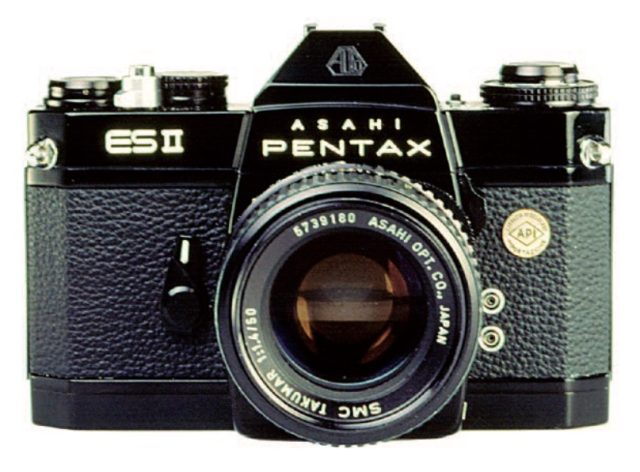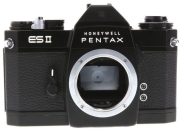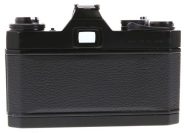Announced
Production status
System
Asahi Pentax M42 system cameras
- Asahi Pentax
- Asahi Pentax ES
- Asahi Pentax ES II
- Asahi Pentax K
- Asahi Pentax S
- Asahi Pentax S1
- Asahi Pentax S1a
- Asahi Pentax S2
- Asahi Pentax S3
- Asahi Pentax Spotmatic
- Asahi Pentax Spotmatic F
- Asahi Pentax Spotmatic II
- Asahi Pentax Spotmatic SL
- Asahi Pentax Spotmatic SP 1000
- Asahi Pentax Spotmatic SP 500
- Asahi Pentax SV
- Honeywell Pentax Spotmatic IIa
Asahi Pentax ES II
aka Honeywell Pentax ES II
35mm MF film SLR camera • Discontinued
Specification
| Format: | |
| 35mm full frame | |
Film type: | 135 cartridge-loaded film |
| M42 [45.5mm] | |
| Shutter: | |
Type: | Focal-plane |
Model: | Electronically controlled |
Speeds: | 8 - 1/1000 + B |
| Exposure: | |
Exposure metering: | Through-the-lens (TTL), open-aperture |
Exposure modes: | Aperture-priority Auto |
| Manual | |
| Physical characteristics: | |
Weight: | 879g |
Dimensions: | 143x98x90mm |
Manufacturer description #1
SECOND GENERATION: HONEYWELL PENTAX ES II
Automatic Pentax ES II retains all the features of its predecessor with added features of two automatic settings, a self-timer, a shutter release lock, an expanded ASA scale of 20-3200 and three additional long-exposure shutter speed calibrations of 2, 4 and 8 seconds visible in the viewfinder. New "square" imprinted automatic setting index programs a viewfinder curtain to close blocking light from viewfinder area, a feature useful for close-up, macro photography and extended exposures. Four 1.5-volt silver batteries are housed on the underside near the lens mount. The Pentax ES II is finished in satin black and is available with a 50mm f/1.4 SMCT lens for $649.50 or a 55mm f/1.8 SMCT lens for $599.50.
Manufacturer description #2
THE FUTURE IS NOW.
As a serious photographer, you've probably invested a lot of time and money experimenting with photographic techniques and equipment.
And, taking a cue from the pros you've talked to, you've probably already decided that someday you'll settle on one superior system and build on it.
Now may be that time.
You'll want the best camera body to build your system on. A camera that gives you precise, dependable, easy operation. A camera that gives you automation, even with bellows and extension tubes.
You'll also want superb optics, a system with precision lenses and matched optical accessories that offer you a wide range of photographic capabilities.
You'll want a system that has the service to back up your investment, where you live and wherever you travel.
The system to consider starts with the Honeywell Pentax ES II - the perfectionist's camera. This second generation of the world's first automatic electronic shutter SLR is two giant steps ahead of any other - truly the camera of the future, available now.
Picture perfect exposures. Easily, effortlessly, every time.
ES II automation controls the speed of the electronic shutter precisely, in an infinitely variable range from 8 seconds down to 1/1000 second. If 1/555 or 2-1/59th second gives the best possible exposure, that's exactly what you get.
This camera doesn't control you - you control it. You pre-set the aperture for complete depth-of-field control. You control shutter speed by changing aperture setting. If, for example, you're shooting a speeding car, opening up the lens will increase the shutter speed.
The ES II doesn't take away your creativity, it adds to it.
On the way to building the world's best-selling fine camera line, we learned that professionals and advanced amateurs are the first to adapt to features that make dependable exposures easier.
But when you're ready to start building a professional quality system, you want to be prepared for any contingency, any exposure situation. Spotlighted subjects, for example, with dark background, or strong backlights, on a subject in a dimly lit foreground.
With the ES automatic exposure override system, you can easily compensate for these difficult situations. Just set the exposure factor dial for 1/2X, 2X or 4X. This automatically changes shutter speed for correct exposure of back lit, side lit or shadowed portions of the scene. Automatic compensation that has the same effect as manually opening up or stopping down the lens aperture with old-fashioned cameras. And you can also use this exposure factor dial under more normal lighting conditions, when your creative instinct calls for a low key or high key effect.
This camera of the future has years-ahead matching lenses.
The ES II comes with your choice of 50mm f/1.4 or 55mm f/1.8 Super-Multi-Coated Takumar lens. These revolutionary lenses let up to 99.8% of light pass through each lens surface, so you get truer, more vibrant, better balanced color. Super-Multi-Coating virtually eliminates the flare and glare, the "foggy" look that can ruin good pictures (especially in difficult back lit situations, like shooting into the sun).
Dependably good exposures, perfect color. What more could you want?
True system capability. When you invest in the world's best camera body, you expect to add fine lenses. There are 23 Super-Multi-Coated Takumars, from Fish-Eye to 1000mm Telephoto in the Pentax system.
Included in the 250 matched accessories available are 47 other Super Takumars you can use with the ES II. You may already own some of them. (Think hard about this if you're tempted to buy a cheaper "EE" camera which has the automation in the lens. When you remove these lenses, you uncouple the system and defeat the automatic operation.)
More reasons to make the ES II your systems camera: Self-timer; FP and X sync; battery checker; PC terminal; hot shoe; shutter release lock. Every fine feature you'd expect to find in the camera of the future.
Manufacturer description #3
Asahi Pentax ES II is the most exciting 35 mm SLR camera on the market today. It comes equipped with a through-the-lens metering system with focal-plane electronic shutter for automatic exposure control. The fully automatic electronic shutter operates just like an electronic computer assuring you of perfect exposures everytime. The new electronic shutter lets you shoot automatically at any speed between 1/1000 and 8 seconds! If the exact shutter speed should be 1/459, 1/733 or 1/952 seconds, then that's the shutter speed that will be automatically selected. Our patented memory device and electronic shutter make it possible. There's also an exposure control dial for intentional over- or under-exposures.
The Pentax ES II is the automatic single-lens reflex camera that works automatically without special lenses. It operates automatically with virtually all Takumar lenses, as well as, bellows, extension tubes, and other close-up accessories. The reason is, unlike other cameras, the automation is incorporated into the body itself, not into the lens. Pentax ES II is equipped with a Super-Multi-Coated Takumar lens. Excusively developed by Pentax, Super-Multi-Coated Takumar lenses reduce flare and boost contrast to a degree far beyond what was previously possible in optical technology. Your pictures will have more detail and richer colors than is possible with any other system at any price.
***
TYPE: 35mm TTL-metering SLR camera with focal-plane electronic shutter for automatic exposure control.
FILM AND PICTURE SIZE: 35mm film. 24mm x 36mm.
SHUTTERS: TTL-metering electronic shutter for automatic exposure control + mechanical shutter for manual speed selection. Horizontal run focal plane shutter. Electronic shutter speeds: unlimited variation between 8 and 1/1000 sec. Mechanical shutter: 1/60 (X), 1/125, 1/250, 1/500, 1/1000 sec. Shutter button safety lock also serves for Time exposure.
SELF-TIMER: Built-in self-timer with interrupt function. Releases shutter in 5-11 sec.
VIEWFINDER: Eye-level pentaprism finder with Fresnel lens + microprism. 0.89x magnification with 50mm lens. -1.0 dioptry. Life-size magnification with 55mm lens. -1.0 dioptry. 93% viewfinder coverage. Viewfinder blinds can be closed in automatic shutter mode. Shutter speed calibration, TTL meter needle and battery check mark in the viewfinder screen.
FOCUSING: Turn the distance scale ring until the subject image in the viewfinder comes into sharp focus.
REFLEX MIRROR: Instant return type.
FILM ADVANCE: Ratchet type rapid wind lever. 10 deg. pre-advance and 160 deg. advance angle.
FILM REWIND: Rapid rewind crank. Film rewind button on base of camera body releases film from take-up spool rewind.
FILM EXPOSURE COUNTER: Automatic re-set type.
COCKED INDICATOR: A red disk appears in a small window alongside the shutter release button when the shutter is cocked, and blacks out when it is released.
LENS MOUNT: 42mm thread (Pentax-mount).
FLASH SYNCHRONIZATION: FP + X contacts for conventional flash cord connection. X contact on hot shoe for convenient flash cordless connection.
EXPOSURE METER: CdS-activated TTL meter for open-diaphragm and stop-down reading. Light measurement range: EV1-18 with ASA 100 film. ASA speed scale: 20-3200.
EXPOSURE FACTOR CONTROL DIAL: 1x for normal exposure. 2x, 4x, 1/2x for intentional over- or under-exposure.
POWER SOURCE: Four 1.5V silver oxide batteries (Eveready S76E or Mallory MS-76H).
FILM TYPE INDICATOR: black & white, color daylight, color tungsten and EMP. (empty).
From the Classic Camera magazine (February 1998)
Two years after its launch, the Asahi Pentax ES was replaced by an improved model, simply designated Asahi Pentax ES II. The new camera offered the same basic performance as the original, as well as a host of improvements. The Asahi Pentax ES II was again equipped with a self timer, actuated by a lever placed at the front. Film speed was extended to 3200 ASA and a mechanical lock was added to avoid accidental release of the shutter. An eyepiece protection blind could be set by the shutter speed selector. In the viewfinder, the shutter speed range occupied the same position, but was extended to 8s. Apart from the presence of the self timer lever at the front, the outer appearance of the ES II was unchanged. The ES II logo remained prominent at the front and the lens throat became longer in order to house four 1.5 V button batteries in its base, each in its own slot. The four cells are aligned and use the same cover. Slightly improved in performance, the Asahi Pentax ES II still offered manual speed selection from 1/60s to 1/1000s and B setting and full speed selection, from the slowest to 1/1000s in automatic exposure mode. As the ES, Asahi Pentax ES II cameras were mostly finished in black and designated by serial numbers starting from 6,600,000. Total production of the Asahi Pentax ES II was slightly more than that of the ES and a limited number of the new model was made with connections to accept a motor drive, of the same type made for the Spotmatic Motor Drive and Spotmatic F Motor Drive.
From the editor
The weight and dimensions are indicated for the camera body with the SMC Takumar 55mm F/1.8 lens mounted.
Similar cameras (151)
35mm full frame • Manual focus • Film • Singe-lens reflex • M42 mount
| Model | Shutter | Metering | Modes | Year |
|---|---|---|---|---|
| Alpa Si 2000 | E, 1/2000 | TTL • WA | AM | 1977 ● |
| Argus CR-3E | E, 1/2000 | TTL • WA | M | ● |
| Argus/Cosina STL 1000 | M, 1/1000 | TTL • WA | M | 1970 ● |
| Chinon AM-3 | M, 1/1000 | TTL • WA | M | ● |
| Chinon CE II Memotron | E, 1/2000 | TTL • WA | AM | 1975 ● |
| Chinon CE Memotron | E, 1/2000 | TTL • WA | AM | 1973 ● |
| Chinon CE-3 Memotron | E, 1/1000 | TTL • WA | AM | 1977 ● |
| Chinon CM-1 | M, 1/1000 | TTL • WA | M | ● |
| Chinon CM-3 | M, 1/1000 | TTL • WA | M | 1977 ● |
| Chinon CS | M, 1/1000 | TTL • WA | M | 1976 ● |
| Chinon CS-4 | M, 1/1000 | TTL • WA | M | ● |
| Chinon CX | M, 1/1000 | TTL • WA | M | ● |
| Chinon CX II | M, 1/1000 | TTL • WA | M | 1976 ● |
| Chinon LED Promaster | M, 1/1000 | TTL • WA | M | ● |
| Chinon M-1 | M, 1/1000 | TTL • WA | M | 1973 ● |
| Chinon SLR | M, 1/1000 | TTL • WA | M | 1979 ● |
| Chinonflex TTL | M, 1/1000 | TTL • WA | M | ● |
| Contax D aka ConSol aka HEXACON aka Pentacon |
M, 1/1000 | -- | M | 1951 ● |
| Contax E aka Pentacon E |
M, 1/1000 | Window | M | 1956 ● |
| Contax F aka Pentacon F |
M, 1/1000 | -- | M | 1956 ● |
| Contax FB aka Pentacon FB |
M, 1/1000 | Window | M | 1956 ● |
| Contax FBM aka Pentacon FBM |
M, 1/1000 | Window | M | 1958 ● |
| Contax FM aka Pentacon FM |
M, 1/1000 | -- | M | 1958 ● |
| Contax S | M, 1/1000 | -- | M | 1949 ● |
| Cosina 1000S | M, 1/1000 | TTL • WA | M | 1975 ● |
| Cosina 4000S aka Vivitar 400/SL |
M, 1/1000 | TTL • WA | M | 1976 ● |
| Cosina CSL / CSM aka Vivitar XC-3 |
E, 1/1000 | TTL • WA | M | 1977 ● |
| Cosina CSR aka Vivitar XC-2 |
E, 1/1000 | TTL • WA | M | 1976 ● |
| Cosina Hi-Lite | M, 1/1000 | TTL • WA | M | 1968 ● |
| Cosina Hi-Lite 202 aka Vivitar 220/SL |
M, 1/1000 | TTL • WA | M | 1975 ● |
| Cosina Hi-Lite 205 aka Vivitar 250/SL |
M, 1/1000 | TTL • WA | M | 1976 ● |
| Cosina Hi-Lite 402 aka Vivitar 420/SL |
M, 1/1000 | TTL • WA | M | 1975 ● |
| Cosina Hi-Lite 405 aka Vivitar 450/SLD |
M, 1/1000 | TTL • WA | M | 1975 ● |
| Cosina Hi-Lite DL / DLR aka Edixa 2MTL |
M, 1/1000 | TTL • WA | M | 1970 ● |
| Cosina Hi-Lite EC aka Argus/Cosina EC 2000 |
E, 1/2000 | TTL • WA | AM | 1972 ● |
| Cosina Voigtlander Bessaflex TM | M, 1/2000 | TTL • WA | M | 2003 ● |
| Exa 1b aka Exa 1c |
M, 1/175 | -- | M | 1977 ● |
| Exakta FE 2000 | M, 1/1000 | TTL • OA | SM | 1976 ● |
| Exakta TL 1000 | M, 1/1000 | TTL • WA | M | 1976 ● |
| Exakta TL 500 | M, 1/500 | TTL • WA | M | 1975 ● |
| Exakta Twin TL 42 | M, 1/1000 | TTL • WA | M | ● |
| Fujica AZ-1 | E, 1/1000 | TTL • OA | AM | 1977 ● |
| Fujica ST601 | M, 1/700 | TTL • WA | M | 1975 ● |
| Fujica ST605 | M, 1/700 | TTL • WA | M | 1976 ● |
| Fujica ST605 II | M, 1/700 | TTL • OA | M | 1978 ● |
| Fujica ST605N | M, 1/700 | TTL • WA | M | 1978 ● |
| Fujica ST701 | M, 1/1000 | TTL • WA | M | 1970 ● |
| Fujica ST705 | M, 1/1500 | TTL • OA | M | 1976 ● |
| Fujica ST705W | M, 1/1500 | TTL • OA | M | 1978 ● |
| Fujica ST801 | M, 1/2000 | TTL • OA | M | 1972 ● |
| Fujica ST901 | E, 1/1000 | TTL • OA | AM | 1974 ● |
| Mamiya DSX 1000 | M, 1/1000 | TTL • OA | M | 1974 ● |
| Mamiya DSX 1000B | M, 1/1000 | TTL • OA | M | 1975 ● |
| Mamiya DSX 500 | M, 1/500 | TTL • OA | M | 1974 ● |
| Mamiya MSX 1000 | M, 1/1000 | TTL • OA | M | 1974 ● |
| Mamiya MSX 500 | M, 1/500 | TTL • OA | M | 1974 ● |
| Mamiya/Sekor 1000 DTL | M, 1/1000 | TTL • WA | M | 1968 ● |
| Mamiya/Sekor 1000 TL | M, 1/1000 | TTL • WA | M | 1966 ● |
| Mamiya/Sekor 2000 DTL | M, 1/2000 | TTL • WA | M | 1969 ● |
| Mamiya/Sekor 500 DTL | M, 1/1000 | TTL • WA | M | 1968 ● |
| Mamiya/Sekor 500 TL | M, 1/500 | TTL • WA | M | 1966 ● |
| Mamiya/Sekor CP aka Mamiya/Sekor CWP |
M, 1/1000 | Window | M | 1964 ● |
| Olympus FTL | M, 1/1000 | TTL • OA | M | 1970 ● |
| Pentacon super | M, 1/2000 | TTL • OA | M | 1968 ● |
| Pentaflex SL | M, 1/500 | -- | M | 1967 ● |
| Petri Penta | M, 1/500 | -- | M | 1959 ● |
| Praktica | M, 1/500 | -- | M | 1949 ● |
| Praktica DTL 2 | M, 1/1000 | TTL • WA | M | 1978 ● |
| Praktica DTL 3 | M, 1/1000 | TTL • WA | M | 1979 ● |
| Praktica EE 2 | E, 1/1000 | TTL • OA | AM | 1977 ● |
| Praktica EE 3 | E, 1/1000 | TTL • OA | AM | 1979 ● |
| Praktica FX aka Praktiflex FX |
M, 1/500 | -- | M | 1952 ● |
| Praktica FX 2 aka Praktica FX 3 |
M, 1/500 | -- | M | 1956 ● |
| Praktica III | M, 1/500 | -- | M | 1955 ● |
| Praktica IV (early) | M, 1/500 | -- | M | 1959 ● |
| Praktica IV (late) | M, 1/500 | -- | M | 1960 ● |
| Praktica IV B | M, 1/500 | Window | M | 1961 ● |
| Praktica IV BM | M, 1/500 | Window | M | 1961 ● |
| Praktica IV F | M, 1/500 | -- | M | 1963 ● |
| Praktica IV FB | M, 1/500 | Window | M | 1963 ● |
| Praktica IV M | M, 1/500 | -- | M | 1961 ● |
| Praktica L aka Praktica autoreflex S |
M, 1/1000 | -- | M | 1969 ● |
| Praktica L 2 | M, 1/1000 | -- | M | 1975 ● |
| Praktica LB aka Praktica autoreflex SL |
M, 1/1000 | Window | M | 1972 ● |
| Praktica LB 2 | M, 1/1000 | Window | M | 1976 ● |
| Praktica LLC | M, 1/1000 | TTL • OA | M | 1969 ● |
| Praktica LTL aka Praktica autoreflex S-TL |
M, 1/1000 | TTL • WA | M | 1970 ● |
| Praktica LTL 2 | M, 1/1000 | TTL • WA | M | 1975 ● |
| Praktica LTL 3 | M, 1/1000 | TTL • WA | M | 1975 ● |
| Praktica mat | M, 1/1000 | TTL • WA | M | 1965 ● |
| Praktica MTL 3 | M, 1/1000 | TTL • WA | M | 1978 ● |
| Praktica MTL 5 | M, 1/1000 | TTL • WA | M | 1983 ● |
| Praktica MTL 50 | M, 1/1000 | TTL • WA | M | 1985 ● |
| Praktica MTL 5B aka Praktica MTL NOVA B aka Praktica TL 5B |
M, 1/1000 | TTL • WA | M | 1985 ● |
| Praktica nova | M, 1/500 | -- | M | 1964 ● |
| Praktica nova B | M, 1/500 | Window | M | 1965 ● |
| Praktica PL electronic | E, 1/500 | -- | M | 1967 ● |
| Praktica PL nova I | M, 1/500 | -- | M | 1967 ● |
| Praktica PL nova IB | M, 1/500 | Window | M | 1967 ● |
| Praktica PLC 2 | M, 1/1000 | TTL • OA | M | 1975 ● |
| Praktica PLC 3 | M, 1/1000 | TTL • OA | M | 1978 ● |
| Praktica super TL | M, 1/500 | TTL • WA | M | 1968 ● |
| Praktica super TL 2 aka Praktica 1000 |
M, 1/500 | TTL • WA | M | 1975 ● |
| Praktica super TL 3 | M, 1/500 | TTL • WA | M | 1978 ● |
| Praktica super TL1000 aka Praktica MTL 3 aka Praktica MTL 5 aka Praktica NOVA II aka Praktica PM 3 aka Praktica TL 3 |
M, 1/1000 | TTL • WA | M | 1980 ● |
| Praktica super TL500 | M, 1/500 | TTL • WA | M | 1981 ● |
| Praktica V F | M, 1/500 | -- | M | 1964 ● |
| Praktica V FB | M, 1/500 | Window | M | 1965 ● |
| Praktica VLC | M, 1/1000 | TTL • OA | M | 1974 ● |
| Praktica VLC 2 | M, 1/1000 | TTL • OA | M | 1976 ● |
| Praktica VLC 3 | M, 1/1000 | TTL • OA | M | 1976 ● |
| Ricoh Auto TLS EE | M, 1/1000 | TTL • OA | SM | 1976 ● |
| Ricoh Singlex II | M, 1/1000 | TTL • WA | M | 1976 ● |
| Ricoh Singlex TLS | M, 1/1000 | TTL • WA | M | 1967 ● |
| Ricoh SLX 500 | M, 1/500 | TTL • WA | M | 1975 ● |
| Ricoh TLS 401 | M, 1/1000 | TTL • WA | M | 1970 ● |
| Sigma Mark-I | M, 1/1000 | TTL • WA | M | 1975 ● |
| Voigtlander VSL1 (TM) aka Ifbaflex M 102 |
M, 1/1000 | TTL • OA | M | 1974 ● |
| Yashica Electro AX | E, 1/1000 | TTL • WA | AM | 1972 ● |
| Yashica FFT | M, 1/1000 | TTL • WA | M | 1973 ● |
| Yashica J-3 | M, 1/500 | Window | M | 1962 ● |
| Yashica J-4 | M, 1/500 | Window | M | 1965 ● |
| Yashica J-5 | M, 1/1000 | Window | M | 1964 ● |
| Yashica J-7 | M, 1/1000 | Window | M | 1966 ● |
| Yashica J-P | M, 1/500 | -- | M | 1964 ● |
| Yashica Penta J aka Yashica Reflex 35 |
M, 1/500 | -- | M | 1961 ● |
| Yashica TL | M, 1/500 | TTL • WA | M | 1968 ● |
| Yashica TL Electro X | E, 1/1000 | TTL • WA | M | 1968 ● |
| Yashica TL Electro X ITS | E, 1/1000 | TTL • WA | M | 1970 ● |
| Yashica TL-E | M, 1/500 | TTL • WA | M | 1969 ● |
| Yashica TL-Electro | M, 1/1000 | TTL • WA | M | 1972 ● |
| Yashica TL-Super | M, 1/1000 | TTL • WA | M | 1966 ● |
| Zeiss Ikon Icarex 35 (TM) | M, 1/1000 | -- | M | 1969 ● |
| Zeiss Ikon Icarex 35S (TM) | M, 1/1000 | TTL • OA | M | 1969 ● |
| Zeiss Ikon SL706 | M, 1/1000 | TTL • OA | M | 1971 ● |
| Zenit-10 aka Зенит-10 |
M, 1/500 | Window | M | 1982 ● |
| Zenit-11 aka Зенит-11 |
M, 1/500 | Window | M | 1982 ● |
| Zenit-122[V] aka Зенит-122[В] |
M, 1/500 | TTL • WA | M | 1990 ● |
| Zenit-12sd aka Zenit-12xp aka Зенит-12сд |
M, 1/500 | TTL • WA | M | 1983 ● |
| Zenit-15M | M, 1/500 | TTL • WA | M | ● |
| Zenit-16 aka Зенит-16 |
M, 1/1000 | TTL • OA | M | 1975 ● |
| Zenit-18 aka Зенит-18 |
E, 1/1000 | TTL • OA | AM | 1980 ● |
| Zenit-19 aka Зенит-19 |
E, 1/1000 | TTL • WA | M | 1979 ● |
| Zenit-312m | M, 1/500 | TTL • WA | M | 1999 ● |
| Zenit-412DX | M, 1/500 | TTL • WA | M | 2000 ● |
| Zenit-412LS | M, 1/500 | TTL • WA | M | 2002 ● |
| Zenit-E aka Зенит-Е |
M, 1/500 | Window | M | 1965 ● |
| Zenit-EM aka Зенит-ЕМ |
M, 1/500 | Window | M | 1972 ● |
| Zenit-ET aka Зенит-ЕТ |
M, 1/500 | Window | M | 1981 ● |
| Zenit-TTL aka Zenit-12 aka Зенит-12 aka Зенит-TTL |
M, 1/500 | TTL • WA | M | 1978 ● |
| Zenit-V aka Зенит-В |
M, 1/500 | -- | M | 1968 ● |




